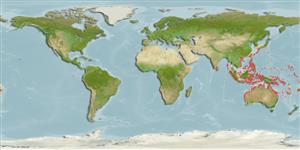>
Gobiiformes (Gobies) >
Gobiidae (Gobies) > Gobiinae
Etymology: Gobiodon: Latin, gobius = gudgeon + Greek, odous = teeth (Ref. 45335).
Environment: milieu / climate zone / depth range / distribution range
Ecologia
marinhas associadas(os) a recifes; intervalo de profundidade 0 - 8 m (Ref. 94251). Tropical
Distribuição
Países | Áreas da FAO | Ecossistemas | Ocorrências | Point map | Introduções | Faunafri
West Pacific: Indonesia, Cocos Is., Japan (Ryukyu Is.), Micronesia (Ponape), Australia and Papua New Guinea.
Tamanho / Peso / Idade
Maturity: Lm ? range ? - ? cm
Max length : 5.4 cm TL macho/indeterminado; (Ref. 11344)
Descrição suscinta
Chaves de identificação | Morfologia | Morfometria
Espinhos dorsais (total) : 7; Raios dorsais (total) : 10 - 11; Espinhos anais: 1; Raios anais : 8 - 10; Vértebras: 26. This species possess many reddish spots/stripes on a yellow-green or sky-blue body; when alive or freshly-collected, it can be distinguished from similar reddish-spotted/lined congeners (G. aoyagii and G. histrio), by having the following set of details in color: 5-6 (usually 5) vertical reddish bars on head and pectoral-fin base; bars on cheek and operculum relatively short, usually not or barely reaching dorsally beyond a level of dorsal margin of eye; 3-8 longitudinal series of rounded or longitudinally elongate scarlet/reddish spots on body, sometimes continuous and forming longitudinal stripes; dorsal, anal and caudal fins are pale yellow with very narrow black distal margins; absence of a black spot at dorsoposterior corner of operculum. In alcohol-preserved specimens, all reddish spots are largely or entirely faded, but this species can still be distinguished from congeners by having a deep, inflected interopercle-isthmus groove; a series of minute non-imbricate cycloid scales on midlateral body; 6-7 upper or lower unsegmented caudal-fin rays; absence of a distinct dusky spot at dorsoposterior corner of operculum. Urogenital papilla in males are more narrowed distally and nearly triangular, while is females it is broader and nearly rectangular (Ref. 94251).
Facultative air-breathing (Ref. 126274); This species is observed to be found among branches of table-like corals, usually Acropora nasuta, also A. valida, A. millepora (the coarse branched form) and sometimes
A. tenuis (Ref. 94251).
Ciclo de vida ou comportamento de acasalamento
Maturities | Reprodução | Spawnings | Egg(s) | Fecundities | Larvas
Bi-directional sex change has been confirmed for this species (Ref. 103751).
Shibukawa, K., Suzuki, T. and M. Aizawa, 2013. Gobiodon aoyagii, a new coral goby (Actinopterygii, Gobiidae, Gobiinae) from the West Pacific, with redescription of a similarly colored Congener Gobiodon erythrospilus Bleeker, 1875. Bull. Nat. Mus. Nat. Sci. 39(3):143-165. (Ref. 94251)
Status na Lista Vermelha da UICN (Ref. 130435)
Ameaça para os humanos
Harmless
Uso pelos humanos
Ferramentas
Relatórios especiais
Baixar XML
Fontes da internet
Estimates based on models
Preferred temperature (Ref.
123201): 24.6 - 29.3, mean 28.5 °C (based on 1991 cells).
Índice de diversidade filogenética (Ref.
82804): PD
50 = 0.5000 [Uniqueness, from 0.5 = low to 2.0 = high].
Bayesian length-weight: a=0.01995 (0.00906 - 0.04395), b=3.01 (2.83 - 3.19), in cm total length, based on all LWR estimates for this body shape (Ref.
93245).
Nível Trófico (Ref.
69278): 3.4 ±0.5 se; based on size and trophs of closest relatives
Resiliência (Ref.
120179): Elevada, tempo mínimo de duplicação da população menor que 15 meses (Preliminary K or Fecundity.).
Fishing Vulnerability (Ref.
59153): Low vulnerability (10 of 100).
Nutrients (Ref.
124155): Calcium = 207 [89, 434] mg/100g; Iron = 1.03 [0.49, 2.13] mg/100g; Protein = 18 [16, 20] %; Omega3 = 0.111 [0.043, 0.230] g/100g; Selenium = 19.7 [8.8, 44.3] μg/100g; VitaminA = 92.3 [22.1, 375.0] μg/100g; Zinc = 2.23 [1.36, 3.55] mg/100g (wet weight);
